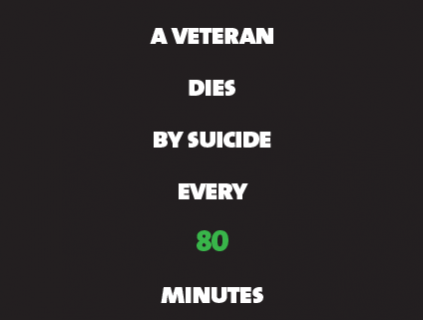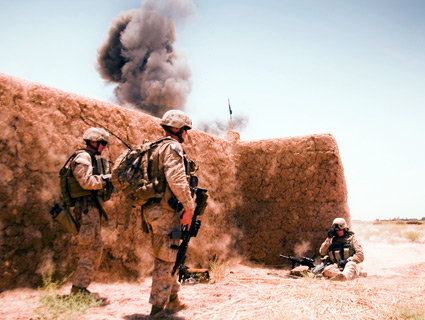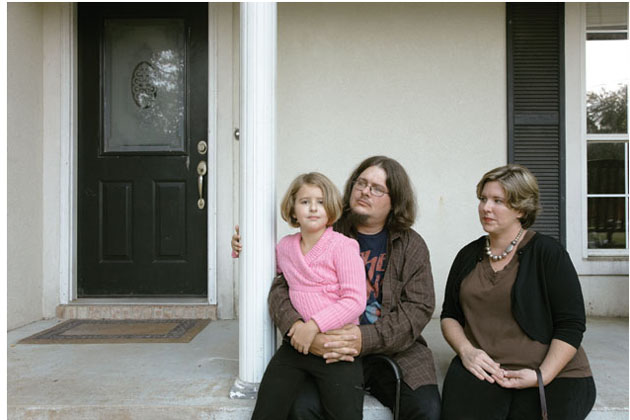
Katie, Caleb, and Brannan VinesPhotos by Brady Fontenot
Brannan Vines has never been to war. But she’s got a warrior’s skills: hyperawareness, hypervigilance, adrenaline-sharp quick-scanning for danger, for triggers. Super stimuli-sensitive. Skills on the battlefield, crazy-person behavior in a drug store, where she was recently standing behind a sweet old lady counting out change when she suddenly became so furious her ears literally started ringing. Being too cognizant of every sound—every coin dropping an echo—she explodes inwardly, fury flash-incinerating any normal tolerance for a fellow patron with a couple of dollars in quarters and dimes. Her nose starts running she’s so pissed, and there she is standing in a CVS, snotty and deaf with rage, like some kind of maniac, because a tiny elderly woman needs an extra minute to pay for her dish soap or whatever.
Brannan Vines has never been to war, but her husband, Caleb, was sent to Iraq twice, where he served in the infantry as a designated marksman. He’s one of 103,200, or 228,875, or 336,000 Americans who served in Iraq or Afghanistan and came back with PTSD, depending on whom you ask, and one of 115,000 to 456,000 with traumatic brain injury. It’s hard to say, with the lack of definitive tests for the former, undertesting for the latter, underreporting, under or over-misdiagnosing of both. And as slippery as all that is, even less understood is the collateral damage, to families, to schools, to society—emotional and fiscal costs borne long after the war is over.
Like Brannan’s symptoms. Hypervigilance sounds innocuous, but it is in fact exhaustingly distressing, a conditioned response to life-threatening situations. Imagine there’s a murderer in your house. And it is dark outside, and the electricity is out. Imagine your nervous system spiking, readying you as you feel your way along the walls, the sensitivity of your hearing, the tautness in your muscles, the alertness shooting around inside your skull. And then imagine feeling like that all the time.
Caleb has been home since 2006, way more than enough time for Brannan to catch his symptoms. The house, in a subdivision a little removed from one of many shopping centers in a small town in the southwest corner of Alabama, is often quiet as a morgue. You can hear the cat padding around. The air conditioner whooshes, a clock ticks. When a sound erupts—Caleb screaming at Brannan because she’s just woken him up from a nightmare, after making sure she’s at least an arm’s length away in case he wakes up swinging—the ensuing silence seems even denser. Even when everyone’s in the family room watching TV, it’s only connected to Netflix and not to cable, since news is often a trigger. Brannan and Caleb can be tense with their own agitation, and tense about each other’s. Their German shepherd, a service dog trained to help veterans with PTSD, is ready to alert Caleb to triggers by barking, or to calm him by jumping onto his chest. This PTSD picture is worse than some, but much better, Brannan knows, than those that have devolved into drug addiction and rehab stints and relapses. She has not, unlike military wives she advises, ever been beat up. Nor jumped out of her own bed when she got touched in the middle of the night for fear of being raped, again. Still.
“Sometimes I can’t do the laundry,” Brannan explains, reclining on her couch. “And it’s not like, ‘Oh, I’m too tired to do the laundry,’ it’s like, ‘Um, I don’t understand how to turn the washing machine on.’ I am looking at a washing machine and a pile of laundry and my brain is literally overwhelmed by trying to figure out how to reconcile them.” She sounds like she might start crying, not because she is, but because that’s how she always sounds, like she’s talking from the top of a clenched throat, tonally shaky and thin. She looks relaxed for the moment, though, the sun shining through the windows onto her face in this lovely leafy suburb. We raise the blinds in the afternoons, but only if we are alone. When we hear Caleb pulling back in the driveway, we jump up and grab their strings, plunging the living room back into its usual necessary darkness.
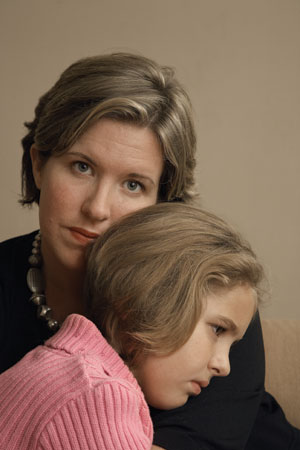
The Vineses’ wedding album is gorgeous, leather-bound, older and dustier than you might expect given their youth. Brannan is 32 now, but in her portraits with the big white dress and lacy veil she’s not even old enough to drink. There were 500 people at the ceremony. Even the mayor was there. And there’s Caleb, slim, in a tux, three years older than Brannan at 22, in every single picture just about the smilingest motherfucker you’ve ever seen, in a shy kind of way.
Now, he’s rounder, heavier, bearded, and long-haired, obviously tough even if he weren’t prone to wearing a COMBAT INFANTRYMAN cap, but still not the guy you picture when you see his “Disabled Veteran” license plates. Not the old ‘Nam guy with a limp, or maybe the young legless Iraq survivor, that you’d expect.
It’s kind of hard to understand Caleb’s injuries. Even doctors can’t say for sure exactly why he has flashbacks, why he could be standing in a bookstore when all of a sudden he’s sure he’s in Ramadi, the pictures in his brain disorienting him among the stacks, which could turn from stacks to rows of rooftops that need to be scanned for snipers. Sometimes he starts yelling, and often he doesn’t remember anything about it later. They don’t know exactly why it comes to him in dreams, and why especially that time he picked up the pieces of Baghdad bombing victims and that lady who appeared to have thrown herself on top of her child to save him only to find the child dead underneath torments him when he’s sleeping, and sometimes awake. They don’t know why some other guys in his unit who did and saw the same stuff that Caleb did and saw are fine but Caleb is so sensitive to light, why he can’t just watch the news like a regular person without feeling as if he might catch fire. Some hypotheses for why PTSD only tortures some trauma victims blame it on unhappily coded proteins, or a misbehaving amygdala. Family history, or maybe previous trauma.
Whatever is happening to Caleb, it’s as old as war itself. The ancient historian Herodotus told of Greeks being honorably dismissed for being “out of heart” and “unwilling to encounter danger.” Civil War doctors, who couldn’t think of any other thing that might be unpleasant about fighting the Civil War but homesickness, diagnosed thousands with “nostalgia.” Later, it was deemed “irritable heart.” In World War I it was called “shell shock.” In World War II, “battle fatigue.” It wasn’t an official diagnosis until 1980, when Post Traumatic Stress Disorder made its debut in psychiatry’s Diagnostic and Statistical Manual of Mental Disorders, uniting a flood of Vietnam vets suffering persistent psych issues with traumatized civilians—previously assigned labels like “accident neurosis” and “post-rape syndrome”—onto the same page of the DSM-III.
But whatever people have called it, they haven’t been likely to grasp or respect it. In 1943, when Lt. General George S. Patton met an American soldier at an Italian hospital recovering from “nerves,” Patton slapped him and called him a coward. In 2006, the British Ministry of Defence pardoned some 300 soldiers who had been executed for cowardice and desertion during World War I, having concluded that many were probably just crippled by PTSD.
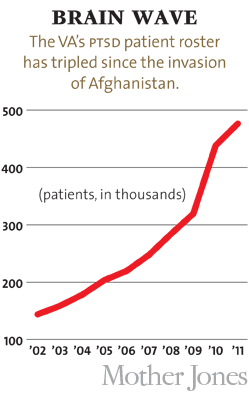
Granted, diagnosing PTSD is a tricky thing. The result of a malfunctioning nervous system that fails to normalize after trauma and instead perpetrates memories and misfires life-or-death stress for no practical reason, it comes in a couple of varieties, various complexities, has causes ranging from one lightning-fast event to drawn-out terrors or patterns of abuse—in soldiers, the incidence of PTSD goes up with the number of tours and amount of combat experienced. As with most psychiatric diagnoses, there are no measurable objective biological characteristics to identify it. Doctors have to go on hunches and symptomology rather than definitive evidence. And the fact that the science hasn’t fully caught up with the suffering, that Caleb can’t point to something provably, biologically ruining his life, just makes him feel worse. It’s invalidating. Even if something is certainly wrong—even if a couple of times he has inadvisably downed his medication with a lot of booze, admitting to Brannan that he doesn’t care if he dies; even if he once came closer to striking her than she ever, ever, ever could have imagined before he went to war—Caleb knows that a person whose problem is essentially that he can’t adapt to peacetime Alabama sounds, to many, like a pussy.
“Somebody at the VA told me, ‘Kids in Congo and Uganda don’t have PTSD,'” Caleb tells me angrily one day.
You can’t see Caleb’s other wound, either. It’s called traumatic brain injury, or TBI, from multiple concussions. In two tours, he was in at least 20 explosions—IEDs, vehicle-borne IEDs, RPGs. In one of them, when a mortar or grenade hit just behind him, he was thrown headfirst through a metal gate and into a courtyard. His buddies dragged him into a corner, where he was in and out of consciousness while the firefight continued, for hours. When it was over, they gave him an IV and some Motrin, and within hours, he was back on patrol. The Army has rules about that sort of thing now. Now if you’re knocked unconscious, or have double vision, or exhibit other signs of a brain injury, you have to rest for a certain period of time, but that rule didn’t go into effect in theater until 2010, after Caleb was already out of the service. He wasn’t diagnosed for years after he got back, despite Brannan’s frantic phone calls to the VA begging for tests, since her husband, formerly a high-scoring civil-engineering major at Auburn University, was asking her to help him do simple division. When Caleb was finally screened for the severity of his TBI, Brannan says he got the second-worst score in the whole 18-county Gulf Coast VA system, which serves more than 50,000 veterans. But there’s still a lot about brain damage that doctors, much less civilians, don’t understand.
“I guess we’re just used to dealing with people with more severe injuries,” a VA nurse once told Brannan upon seeing Caleb.
Unlike PTSD, secondary traumatic stress doesn’t have its own entry in the DSM, though the manual does take note of it, as do many peer-reviewed studies and the Department of Veterans Affairs. Symptoms start at depression and alienation, including the “compassion fatigue” suffered by social workers and trauma counselors. But some spouses and loved ones suffer symptoms that are, as one medical journal puts it, “almost identical to PTSD except that indirect exposure to the traumatic event through close contact with the primary victim of trauma” is the catalyst. Basically your spouse’s behavior becomes the “T” in your own PTSD. If sympathy for Caleb is a little lacking, you can imagine what little understanding exists for Brannan.
Secondary traumatic stress has been documented in the spouses of veterans with PTSD from Vietnam. And the spouses of Israeli veterans with PTSD, and Dutch veterans with PTSD. In one study, the incidence of secondary trauma in wives of Croatian war vets with PTSD was 30 percent. In another study there, it was 39 percent. “Trauma is really not something that happens to an individual,” says Robert Motta, a clinical psychologist and psychology professor at Hofstra University who wrote a few of the many medical-journal articles about secondary trauma in Vietnam vets’ families. “Trauma is a contagious disease; it affects everyone that has close contact with a traumatized person” in some form or another, to varying degrees and for different lengths of time. “Everyone” includes children. Which is something Brannan and Caleb lose not a little sleep over, since they’ve got a six-year-old in the house.
Katie* Vines, the first time I meet her, is in trouble. Not that you’d know it to look at her, bounding up to the car, blondish bob flying as she sprints from her kindergarten class, nice round face like her daddy’s. No one’s the wiser until she cheerfully hands her mother a folder from the backseat she’s hopped into. It contains notes about the day from her teacher.
“It says here,” Brannan says, her eyes narrowing incredulously, “that you spit on somebody today.”
“Yes ma’am,” Katie admits, lowering her voice and her eyes guiltily.
“Katie Vines.” Brannan was born here in Alabama, so that’s drawled. “Wah did you do that?”
Her schoolmate said something mean. Maybe. Katie doesn’t sound sure, or like she remembers exactly. One thing she’s positive of: “She just made me…so. MAD.” Brannan asks Katie to name some of the alternatives. “Walk away, get the teacher, yes ma’am, no ma’am,” Katie dutifully responds to the prompts. She looks disappointed in herself. Her eyebrows are heavily creased when she shakes her head and says quietly again, “I was so mad.”
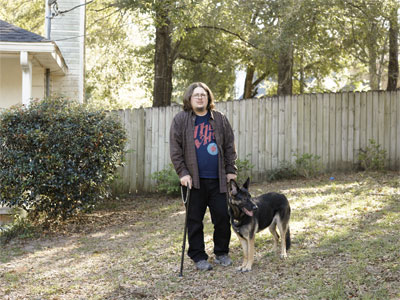
Brannan and Katie’s teacher have conferenced about Katie’s behavior many times. Brannan’s not surprised she’s picked up overreacting and yelling—you don’t have to be at the Vines residence for too long to hear Caleb hollering from his room, where he sometimes hides for 18, 20 hours at a time, and certainly not if you’re there during his nightmares, which Katie is. “She mirrors…she just mirrors” her dad’s behavior, Brannan says. She can’t get Katie to stop picking at the sores on her legs, sores she digs into her own skin with anxious little fingers. She is not, according to Brannan, “a normal, carefree six-year-old.”
Different studies of the children of American World War II, Korea, and Vietnam vets with PTSD have turned up different results: “45 percent” of kids in one small study “reported significant PTSD signs”; “83 percent reported elevated hostility scores.” Other studies have found a “higher rate of psychiatric treatment”; “more dysfunctional social and emotional behavior”; “difficulties in establishing and maintaining friendships.” The symptoms were similar to what those researchers had seen before, in perhaps the most analyzed and important population in the field of secondary traumatization: the children of Holocaust survivors.
But then in 2003, a team of Dutch and Israeli researchers meta-analyzed 31 of the papers on Holocaust survivors’ families, and concluded—to the fury of some clinicians—that when more rigorous controls were applied, there was no evidence for the intergenerational transmission of trauma.
I asked the lead scientist, Marinus van IJzendoorn of Leiden University, what might account for other studies’ finding of secondary trauma in vets’ spouses or kids. He said he’s never analyzed those studies, and wonders if the results would hold up to a meta-analysis. But: “Suppose that there is a second-generation effect in veterans, there are a few differences that are quite significant” from children of Holocaust survivors that “might account for difference in coping mechanisms and resources.” Holocaust survivors “had more resources and networks, wider family members and community to support them to adapt to their new circumstances after a war.” They were not, in other words, expected to man up and get over it.
We await the results of the 20-year, 10,000-family-strong study of impacts on Iraq and Afghanistan veterans’ kin, the largest of its kind ever conducted, that just got under way. Meanwhile, René Robichaux, social-work programs manager for US Army Medical Command, concedes that “in a family system, every member of that system is going to be impacted, most often in a negative way, by mental-health issues.” That was the impetus for the Marriage and Family Therapy Program, which since 2005 has added 70 therapists to military installations around the country. Mostly what the program provides is couples’ counseling. Children are “usually not” treated, but when necessary referred to child psychiatrists—of which the Army has 31. Meanwhile, the Child, Adolescent and Family Behavioral Health Office has trained hundreds of counselors in schools with Army children in and around bases to try to identify and treat coping and behavioral problems early on. “We’re better than we were,” Robichaux says. “But we still have a ways to go.”
Of course, the Army only helps families of active-duty personnel. It’s the Department of Veterans Affairs that’s charged with treating the problems that can persist long past discharge. But “if you asked the VA to treat your kids, they would think it was nonsense,” says Hofstra’s Motta.
When I asked the VA if the organization would treat kids for secondary trauma, its spokespeople stressed that it has made great strides in family services in recent years, rolling out its own program for couples’ counseling and parenting training. “Our goal is to make the parents the strongest parents they can be,” says Susan McCutcheon, national director for Family Services, Women’s Mental Health, and Military Sexual Trauma at the VA; according to Shirley Glynn, a VA clinical research psychologist who was also on the call, “for the vast majority of people with the secondary traumatization model, the most important way to help the family deal with things is to ensure that the veteran gets effective treatment.” In cases where children themselves need treatment, these VA officials recommended that parents find psychologists themselves, though they note “this is a good time [for the VA] to make partners with the community so we can make good referrals.” Or basically: “You’re on your own,” says Brannan.
Brannan sent Katie to the school therapist, once. She hasn’t seen any other therapist, or a therapist trained to deal with PTSD—Brannan knows what a difference that makes, since the volunteer therapist she tried briefly herself spent more time asking her to explain a “bad PTSD day” than how Caleb’s symptoms were affecting the family. When I visited, Katie was not covered by the VA under Caleb’s disability; actually, she wasn’t covered by any insurance at all half the time, since the Vineses aren’t poor enough for subsidized health care and the Blue Cross gap insurance maxes out at six months a year. She’s never been diagnosed with anything, and Brannan prefers it that way. “I’m not for taking her somewhere and getting her labeled. I’d rather work on it in softer ways,” like lots of talks about coping skills, and an art class where she can express her feelings, “until we have to. And I’m hoping we won’t have to.” Certainly she seems better than some other PTSD vets’ kids Brannan knows, who scream and sob and rock back and forth at the sound of a single loud noise, or who try to commit suicide even before they’re out of middle school. Caleb spends enough time worrying that he’s messing up his kid without a doctor saying so.
Brannan is a force of keeping her family together. She sleeps a maximum of five hours a night, keeps herself going with fast food and energy drinks, gets Katie to and from school and to tap dance and art, where Katie produces some startlingly impressive canvases, bright swirling shapes bisected by and intersected with other swaths of color, bold, intricate. That’s typical parent stuff, but Brannan also keeps Caleb on his regimen of 12 pills—antidepressants, anti-anxiety, sleep aids, pain meds, nerve meds, stomach meds—plus weekly therapy, and sometimes weekly physical therapy for a cartilage-lacking knee and the several disintegrating disks in his spine, products of the degenerative joint disease lots of guys are coming back with maybe from enduring all the bomb blasts, and speech therapy for the TBI, and continuing tests for a cyst in his chest and his 48-percent-functional lungs. She used the skills she learned as an assistant to a state Supreme Court justice and running a small newspaper to navigate Caleb’s maze of paperwork with the VA, and the paperwork for the bankruptcy they had to declare while they were waiting years for his disability benefits to come through. She also works for the VA now, essentially, having been—after a good deal more complicated paperwork, visits, and assessments—enrolled in its new caregiver program, which can pay spouses or other family members of disabled vets who have to take care of them full time, in Brannan’s case $400 a week.
At home after school, she makes Katie a pancake snack and then, while Katie shows me the website for a summer camp that teaches military spy skills, Brannan gets back to work. Because she also helps thousands of other people—measured by website and social-media interactions—through Family of a Vet, a nonprofit created “to help you find your way, find the information you need, and find a way not only to cope with life after combat…but to survive and thrive!” Brannan founded the organization in 2007, after panicked Googling led her to the website of Vietnam Veteran Wives (VVW) when Caleb returned from his second tour. Life after the first tour had been pretty normal. “Things were a little…off,” Caleb was edgy, distant, but he did not forget entire conversations minutes later, did not have to wait for a stable mental-health day and good moment between medication doses to be intimate with his wife, and then when he finally tried, pray to Christ for one of the times when it’s good sex, not one of the times when a car door slams outside and triggers him, or the emotion becomes so unbearable that he freezes, gets up, and walks wordlessly out the door.
All that didn’t happen until after the second tour. Brannan was in a terrible place, she says—until she talked to Danna Hughes, founder of VVW. Danna had been through much of the exact same turmoil, decades ago, and had opened a center to help get Vietnam vets benefits and educate their spouses and communities about their condition. “What choice do I have?” Brannan asks about running her own organization. “This is the only reason I am well. People care when you tell them. They just don’t know. They want to help and they want to understand, so I just have to keep going and educating.”
Today she’s fielding phone calls from a woman whose veteran son was committed to a non-VA psychiatric facility, but he doesn’t want to be at the facility because he, a severe-PTSD sufferer, was already paranoid before one of the other resident loons threatened to kill him, and anyway he fought for his fucking country and they promised they wouldn’t abandon him and he swears to God he will have to kill himself if the VA doesn’t put him in with the other soldiers. Another veteran’s wife calls from the parking lot of a diner to which she fled when her husband looked like he was going to boil over in rage. Another woman’s husband had a service dog die in the night, and the death smell in the morning triggered an episode she worries will end in him hurting himself or someone else if she doesn’t get him into a VA hospital, and the closest major clinic is four hours away and she is eight and a half months pregnant and got three hours of sleep, and the clinic’s website says its case manager position for veterans of Iraq or Afghanistan is currently unstaffed, anyway.
The phone never stops ringing. If it does for 14 seconds, Brannan writes an email to help get whatever someone needs, or publishes a blog post about her own struggles. Caleb was not amused the first time one of these posts went live. But now he’s glad she didn’t ask him his permission. “I’d have said no,” he tells me on the couch one day. It’s a brief emergence from his bedroom—he’s been “sleeping or hiding,” Brannan describes it, 20 or so hours a day for a few days. He leans forward to put his glass of orange juice on the table; it takes many, many long seconds for him to cover the few inches; today, like most days, he feels “like a damn train ran over me.” “But because of the feedback she got, I know that other people were going through the same shit I was. And she’s helping people.” His face softens. “She’s got a good heart. She’s always been like that. I’m glad she’s doing it,” he says again, and shrugs, because that’s the end of that story.
“Breathe,” Brannan says to nearly every woman who calls, though when I ask her if she follows her own advice, she says no. “If I stopped, and started breathing,” she says, “I would be too sad.”
So she doesn’t. If she’s not saving lives on the phone or blogging, she’s offering support via Facebook, where thousands of Family of a Vet users and nearly 500 FOV volunteers congregate and commiserate. “I am now more hypervigilant than my husband,” volunteer Kateri Peterson posts to her Facebook page, and people comment things like “I know that even if my husband is having a decent day I am still in that alert mode and he is asking me to please relax and for the life of me, as hard as I try, I just can’t, I am still on the lookout. I know people probably think I am nuts.” On a private Facebook group, Kateri tells the story of how her family was at Olive Garden when she started sobbing into her Zuppa Toscana. There was no visible reason for it. Just the general overwhelmingness of her distress, of that awful overstimulating hypervigilance, the sort of thing you develop sometimes when you live with someone who looks out the living room window for danger literally hundreds of times a day, or who goes from room to room, room to room, over and over to make sure everyone in each one is still alive. Kateri’s eight-year-old son now also counts the exits in new spaces he enters, points them out to his loved ones, keeps a mental map of them at the ready, until war or fire fails to break out, and everyone is safely back home.
It’s to help kids like that that Brannan and her volunteers put together an informational packet on secondary trauma for parents to give to teachers, explaining their battle-worthy idiosyncrasies and sensory-processing sensitivities. They’re common enough problems that the Department of Health and Human Services got in touch with Brannan about distributing the packet more widely.
Brannan gave the packet to Katie’s kindergarten teacher, but thinks the teacher just saw it as an excuse for bad behavior. Last fall, she switched Katie to a different school, where she hopes more understanding will lead to less anxiety. Though Brannan hopes Katie will come out of childhood healthy, she still says, “She’s not a normal kid. She does things, and says things. She’s a grown-up in a six-year-old’s body in a lot of ways.”
She certainly looks like a normal kid when she comes down from her room dressed for tap class. In a black leotard, pink tights, and shiny black tap shoes, she looks sweet as pie.
“One time, a bad guy in Iraq had a knife and my dad killed him,” she says, apropos of nothing.
“Katie Vines.” Brannan is stern but impeccably patient. She doesn’t know why Katie adapted this story about confiscating a weapon from an insurgent into a story about bloodshed, but she isn’t too happy about it. That kind of small talk recently ruined a birthday party one of her classmates was having at Chick-fil-A. Brannan and Katie have a talk, again, about inappropriate conversation. Katie is sorry—God, is she sorry, you can see it in her face and guilty shoulders, but she seems to feel like she can’t help it. Sometimes, at bedtime, she asks her mom to pray with her that her teacher will like her. Once, she asked Brannan to take her to a hypnotist, so he could use his powers to turn her into a good girl.
By this point, you might be wondering, and possibly feeling guilty about wondering, why Brannan doesn’t just get divorced. And she would tell you openly that she’s thought about it. “Everyone has thought about it,” she says. And a lot of people do it. In the wake of Vietnam, 38 percent of marriages failed within the first six months of a veteran’s return stateside; the divorce rate was twice as high for vets with PTSD as for those without. Vietnam vets with severe PTSD are 69 percent more likely to have their marriages fail than other vets. Army records also show that 65 percent of active-duty suicides, which now outpace combat deaths, are precipitated by broken relationships. And veterans, well, one of them dies by suicide every 80 minutes. But even ignoring that though vets make up 7 percent of the United States, they account for 20 percent of its suicides—or that children and teenagers of a parent who’s committed suicide are three times more likely to kill themselves, too—or a whole bunch of equally grim statistics, Brannan’s got her reasons for sticking it out with Caleb.
“I love him,” she says.
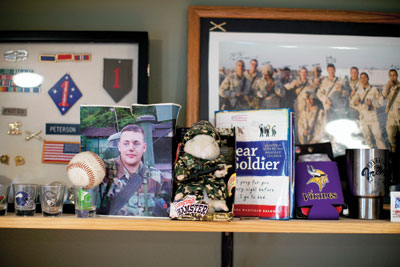
Brannan fully supports any wife—who feels that she or her children are in danger, or in an untenable mental-health environment, or for whatever reason—who decides to leave. She’s here, through Family of a Vet, to help those people. But she’s also there for those FOV users who, like her, have decided to stay. “I have enormous respect for Caleb,” she explains if you ask her why. “He has never stopped fighting for this family. Now, we’ve had little breaks from therapy, but he never stopped going to therapy. I love him,” she repeats, defensively at times.
He is her friend, and her first love, and her rock, and her lifeline, her blossoming young daughter’s father, her ally, and her hero, she tells Caleb when he asks. Because the person who most often asks Brannan why she stays with her husband is her husband.
The amount of progress in Caleb’s six years of therapy has been frustrating for everyone. But ultimately, says Alain Brunet, vice president of the International Society for Traumatic Stress Studies and director of the Traumatic Stress Laboratory at McGill University in Canada, “we have reason to be reasonably optimistic. Psychotherapy does work for typical PTSD.” The VA tends to favor cognitive-behavioral therapy and exposure therapy—whereby traumatic events are hashed out and rehashed until they become, theoretically, less consuming. Some state VA offices also offer group therapy. For severe cases, the agency offers inpatient programs, one of which Caleb resided in for three months in 2010. The VA also endorses eye movement desensitization and reprocessing therapy (EMDR), which is based on the theory that memories of traumatic events are, in effect, improperly stored, and tries to refile them by discussing those memories while providing visual or auditory stimulus. “There’s a fairly strong consensus around CBT and EMDR,” Brunet says. While veterans are waiting for those to work, they’re often prescribed complicated antidepressant-based pharmacological cocktails.
To stay up to date on the latest advances in PTSD treatment, the VA collaborates with outside entities through its Intramural Research Program. Currently, the agency is funding 130 PTSD-related studies, from testing whether hypertension drugs might help to examining the effectiveness of meditation therapy, or providing veterans with trauma-sensitive service dogs, like Caleb’s. The Mental Health Research Portfolio manager says the organization is “highly concerned and highly supportive” of PTSD research.
But a lot of FOV members and users are impatient with the progress. Up until 2006, the VA was spending $9.9 million, just 2.5 percent of its medical and prosthetic research budget, on PTSD studies. In 2009, funding was upped to $24.5 million. But studies take a long time, and any resulting new directives take even longer to be implemented.
Meanwhile people like James Peterson, husband of Kateri of the Olive Garden breakdown, are signing up for experiments. James was so anxious and so suicidal that he couldn’t even muster the self-preservation to get into inpatient treatment. With three kids, eight, five, and two, and Kateri’s full-time job—as a VA nurse, actually—she could no longer manage his emotional plus physical problems: rheumatism consults, neuro consults for TBI, plus a burning rash on both feet he got in Fallujah in 2004. Chemical exposure, stress reaction, no one knows, but the skin cracks and opens up raw with lesions sometimes. Finally they enrolled him in a private clinical trial to get a needleful of anesthetic injected into a bundle of nerves at the top of his collarbone. Kateri writes me that just moments after the injection, he “went from ballstothewall PTSD to *BOOM* chill.”
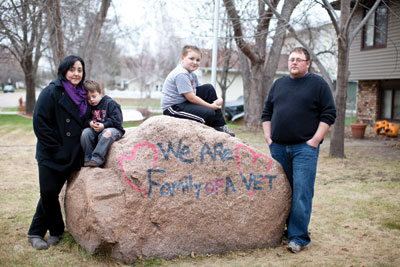
That’s when her symptoms got worse, precipitating another meltdown, this time at a steak house where she took him to celebrate his newfound calm. They’d “assumed the normal positions,” she with her back to the restaurant, he facing it so he could monitor everyone, and suddenly, a server dropped a tray out of her periphery, setting her circulatory system off at a million miles a minute. “He just ate his steak like nothing,” she says.
“When you’ve become hypervigilant, the place you are most functional is on the battlefield,” McGill’s Brunet explains. Caleb, despite his injuries and his admission that war was pretty excruciatingly awful, told me he wishes he could go back. Kateri, despite wishing her system hadn’t learned to run at a heightened state, at this point is like a drug addict, needing stimulation to maintain it. For the first time since Iraq, her husband felt at peace, and was able to enjoy a steak dinner with his wife. “He just sat there,” Kateri says. His normalcy “was so distressing to me that I wanted to stab him.”
There are trials where patients take MDMA (ecstasy’s active ingredient) while talking about trauma to promote more positive and less scary associations with the events. Animal trials where rats are lightly tortured and then injected with a protein that will stop the enzymes in their brains from being able to form memories of it. Some of the most interesting research involves beta-blockers, drugs that suppress the adrenaline response. In one small study, trauma victims given beta-blockers within six hours of the incident had a 40 percent less likelihood of developing PTSD. Brunet runs trials where patients take beta-blockers while talking about trauma so their reactions are weakened and then presumably lessened the next time it comes up, so far with promising results. But as of yet, “pharmacologically, there’s no magic bullet,” he says. And “we’re much less effective at treating more complex PTSD” with traditional therapy. “Treatment offered vets might be less effective than what’s offered to civilians with trauma. With veterans, there are important concomitant issues.”
Like traumatic brain injury. Researchers posit that TBI can make the brain more vulnerable to PTSD, or that it can exacerbate its symptoms of exhaustion, agitation, confusion, headaches. They’re not positive about that, or about whether TBI makes PTSD harder to treat. James Peterson’s post-injection chill-out wore off after a month, faster than it does for other patients—maybe because of his TBI. Maybe not. Either way, as for TBI, well, “there is no cure,” says David Hovda, director of UCLA’s Brain Injury Research Center and an adviser to the Department of Defense.
In 2009, it was Hovda who delivered the Pentagon the recommendation that because multiple concussions could cause serious long-term injury, concussions need time to heal. A fight ensued. Hovda says some of the Army’s best doctors implied that if soldiers were told they needed rest after concussions, it was going to usher in an epidemic of fakers, or retired guys claiming disability way after the fact. Although, the NFL was given the same memo in the 1990s, and brain damage in boxers is even older news, so it doesn’t seem like it would take a neuroscientist—or the top medical brass of an Army that builds laser cannons—to figure out that if 25 mph punches to the head cause brain damage, IED blasts that hit at 330 mph probably do too.
Eventually, Hovda’s cause prevailed. These days, there are MRIs in theater, assessments after blasts, mandatory rest periods after a concussion. But those reforms came seven years into the Iraq War, after Caleb and a million other soldiers were already home. When people ask Hovda if they’re gonna get better, he encourages them that they’re gonna get different. That they will never be the same—researchers “have tried hyperbaric oxygen, hundreds of clinical trials; we’re just failing miserably in trying to make a difference”—but that they should not panic. “There’s good rehabilitation strategies: learn what your deficits are, learn that you’re not going crazy, that you just can’t do what you used to do,” he says. “The human brain has an enormous amount of plasticity. New cells are born every day. New connections can be made. The good news is, teleologically speaking, if we didn’t have the ability to recover from brain injury, we’d have ended up as somebody’s breakfast.”
So tonight, six years after Caleb’s service ended, Brannan is cautiously optimistic but ready for anything on Lasagna Night. Early in the morning, she talked to their dog, Shilo, about it while she browned meat for Caleb’s favorite dish. “Daddy will be really happy,” she told the German shepherd sitting on her kitchen floor. “Of course, he’s too cranky to be happy about anything, and he’ll be mad because Katie won’t eat it because I spent all day makin’ it and the only thing she wants to eat right now is pancakes.” Later, she reminds me that Lasagna Night can come apart in an instant, if Caleb has a “bad PTSD moment.” These are supposed to be her easy months, she sighs, April and May and June, before the anniversaries of his worst firefights—many of them in Ramadi; a lot of bad things happened in Ramadi—exacerbate his flashbacks and nightmares. That’s usually September through January, the “really bad” months, whereas in the spring, she gets a bit of “vacation,” time to clean up the house and catch up on work, rest.
It’s April at the moment. But: “He’s processin’ somethin’ right now.”
She used to ask Caleb what was wrong, why he was coiled so tight and poisonous, screaming and yelling at everybody. That just agitated him more. Now, she lets it go, until eventually, after a couple of days or weeks of refusing to leave the house, or refusing to stay home and just disappearing outside, he comes to her. Haven’t you noticed I’m having a bad time? he’ll ask. And then she’ll just sit and listen while he says he cannot get it out of his head, about how if he had caught that fucking sniper, that enemy sniper he’d been trying to get, that’d been following them around, terrorizing their unit, if he’d have managed to kill him like he was supposed to, then the sniper wouldn’t have gotten off the shot that killed his buddy.
But here we’ve got lasagna, and salad with an array of dressing choices, and a store-bought frosted Bundt cake with chocolate chips in it! There is no dining-room table—when they bought the house years ago, they thought they’d finish it up real nice like they did with another house, before the war, but nobody’s up for that now, so we all huddle around the coffee table in the living room.
And it’s lovely. Dinner lasts for hours. Brannan tries to calm Katie down despite the excitement of the visitor at dinner, while Katie shows me games and drawings as we eat. Brannan and I make fun of Caleb for being three years older than us, so old, and Caleb makes jokes that it does indeed feel like he and Brannan have been married for-ever. The plates have been cleared by then, everyone reclining, he laughs when he says this, and she laughs, and swats at him from where she’s curled herself into his armpit with his arm around her.
At the front door, we all beam at each other in the warm way people do when they’re separating after a nice meal. Caleb is in such a good mood that Brannan asks if he’s up for putting Katie to bed so she can go lie down. Forty-five minutes later, he wakes her up screaming. Not two days after that, he tells her he’s leaving her. “I’m going to get it over with and do it so you don’t have to,” he says, because that’s just the way the scale goes that day, when he weighs the pain of being alone versus the pain of being a burden.
Way up north, and nearly as west as you can go, in Ferry County, Washington, there’s a little town with no stoplights by the name of Republic. There’s an abundance of parks and lakes and campgrounds—though I lose track of how many people warn me not to walk any unknown path for fear of trip wire and booby traps.
“Yeah,” a county commissioner says, squinting against the afternoon sun, speaking of the high proportion of Vietnam veterans who live here, “they wanted to get away from society. And for the most part, they’ve blended in really well.”
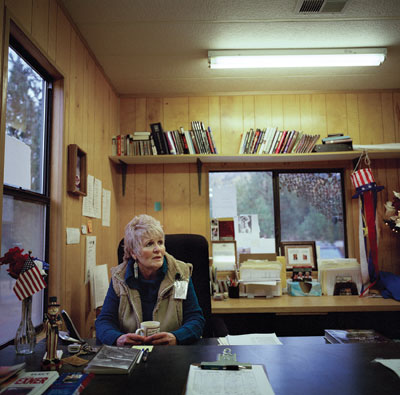
We’re standing together on the grounds of Vietnam Veteran Wives, where Danna Hughes, founder of VVW, inspirer and savior of Brannan Vines, is holding a fundraiser and tribute for our troops. Back in the ’90s, Danna served three counties and some 5,000 former soldiers via the center she founded, established nonprofit status for, and got the VA to recognize and reimburse. A 2000 VA budget crunch led to her clinic’s contract being terminated—and her husband’s disability pay ended when he killed himself in 2001. VVW now has more modest but no less determined facilities: a camouflage-painted mobile home planted among tree-dotted hills. Today, VVW is dedicating a new, second building, a log safe house open 24 hours a day so vets who feel themselves becoming episodic have someplace to go—it’s better than just driving to VVW’s parking lot and sleeping in their trucks. The closest VA hospital is 130 miles from here.
Between 200 and 300 people show up, a big turnout in a county of 7,500 spread over 2,000 square miles. Dressed in a patriotic red shirt and blue jeans, Danna smiles easy but moves pretty slow because she threw her back out again. She tells me that VVW’s No. 1 priority has always been helping vets figure out how to get their benefits. “Money has to be first. You can’t breathe without it.” But it takes more than that. “She,” Danna says, meaning the wife—nearly all the vets around here are men—”NEEDS therapy.” Danna used to be in beauty pageants and it shows, in the subtly flirty but no-nonsense way she addresses everyone. But she knows how it feels to have your nervous system turn against you, and that it’s harder for veterans to get better if their spouses don’t get treated. Danna’s husband was checking into inpatient psych treatments for almost three weeks at a time, she says, only to come back to his now-crazy wife and “within three seconds” be re-exposed to someone in the emotional state that he was in when he left.
It may take years for the verdict to come in on whether secondary trauma will be officially acknowledged as its own unique form of hell. Meanwhile, Hofstra professor Motta says, while “a simple Google search [of the research] would tell you that the children of traumatized people have problems, the VA doesn’t wanna spend the money. Even with veterans, they try to say, ‘Well, you really had a preexisting condition.’ It would cost millions upon millions to treat the people affected. They just don’t want to foot the bill.”
Then again, the VA already is footing some $600 million worth of PTSD treatment for veterans of Iraq and Afghanistan** in 2013, via hundreds of medical centers and smaller outpatient clinics, plus 232 vet centers that offer general readjustment services. Caleb alone, just in disability checks, not even including any of his treatment or his numerous prescriptions, will cost the VA $1.7 million if he lives until he’s 80.
Charles Marmar, a New York University professor who was on the team of the National Vietnam Veterans Readjustment Study, the most comprehensive study of combat stress ever conducted, points out that you really have to spend the money to treat PTSD, since the costs of not treating it are so much higher. “Personal tragedy, suicide, depression, alcohol and drug use, reliving terror,” he rattles off as consequences. “Stress-related health problems—cardiovascular, immunologic. Heart attacks, stroke, and even dementia. Residential rehab programs, and motor vehicle accidents because people with PTSD self-medicate and crash cars; the cost of domestic violence; the cost of children and grandchildren of combat vets witnessing domestic violence. The treatment and compensation disability programs have cost billions. And the costs of the untreated are probably in the tens of billions. They’re enormous.” Police time, court costs, prison time for sick vets who came home to commit soldier-style shoot-’em-ups or plain desperate crimes. Lost wages. Nonprofit assistance, outreach, social services. There are an estimated 100,000 homeless vets on the street on any given night.
Experts say it’s nearly impossible to calculate what treating PTSD from Vietnam has and will cost American taxpayers, so vast are its impacts. There were 2.4 million soldiers deployed to Iraq and Afghanistan, and while no one is sure what PTSD among them will ultimately cost us, either, everyone agrees on one thing: If it’s not effectively treated, it won’t go away. When Caleb checked into his VA inpatient therapy in 2010, more than two-thirds of his fellow patients were veterans of Vietnam.
Vietnam vets still make up the bulk of Danna’s clients—though she is assisting traumatized men who served in World War II, in the early years of which half the medical disability discharges were psychiatric, and some of those men still show up at Danna’s office and cry, and cry, and cry. Many people at her fundraiser are saying that she saved their lives, kept them from killing themselves, kept them off the streets—or out of the woods, as it were, where she sometimes found vets living on earth floors under cardboard boxes.
“I don’t just get to see the bad stuff,” Danna says. “I get to see the good stuff too.”
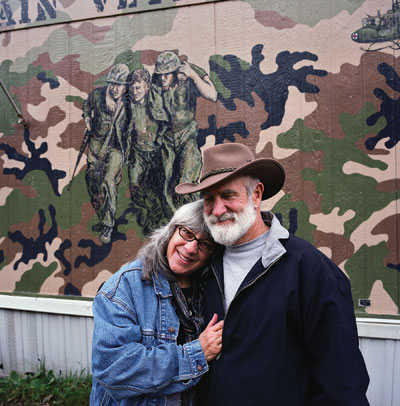
By way of example, she introduces me to Steve Holt*** and Charlene Payton Holt. Steve served in Vietnam, fought in the Tet Offensive. The chaplain assured him that he shouldn’t feel bad about killing gooks, but the chaplain was paid by the Army, and who took moral advice from a chaplain carrying a .38? Back at home, Steve drank wildly. He waged war with his wife, attempted to work odd jobs where he had as little contact with humans as possible. But then he got divorced, and then he got with Charlene in 2001, and then he got in a big fight with Charlene and pulled the rifles out and sent her fleeing into the night, through the woods to the closest neighbor’s house a mile away. But then he got inpatient psychiatric treatment in Seattle, several times, and found Jesus, and only ever has a beer or two, and now you have never seen two people so in love in any double-wide in the United States.
“I knew who he could be,” Charlene says.
Who he is now is a handsome guy in his 60s with a white beard, big but well kept, who refers to his wife as “my bride” after nine years. Hanging around their trailer one day, I see them handle each other with immense patience, even when their computer takes forever to load and they can’t find the files they’re looking for because they’ve been crappily cataloged and it’s not clear whose fault that is. Charlene has long, graying dark hair parted down the middle and super-serious eyes, which she has to lower to compose herself for a minute when I ask her, alone, if she saved Steve’s life. “He loves me a lot,” she answers. “I’ve never known love like this. He is…awesome.”
These most recent years, Steve is funnier—after all, he’s not just any Carson; his dad and Johnny were first cousins—but it’s not all good days. Sometimes, Charlene says, “I can feel him slipping down—it’s like this…vortex, this hole. And I try to grab him, like, ‘No! Don’t go down there!’ He can still get really depressed.” And hypervigilant. He doesn’t like living on Five Cent Ranch Road, which runs through a decidedly vulnerable valley.
“She saved my life,” Steve says of Charlene, without my asking. Of the soldiers coming home with PTSD now, he says, “You need time. You need time, and perspective.” Decades after his service, the VA rated Steve at 100 percent PTSD disabled, but he’s found his way to his version of a joyful life. Although, he qualifies, he saw guys get thrown around in explosions the way Caleb got thrown around in explosions, but he can’t say how their lives turned out in the long run because in his war, with that less-advanced gear, those guys usually died.
Finally, Steve and Charlene find what they’re looking for on their computer: pictures of the land they bought nearby. Steve’s building an artist’s studio for Charlene on it, and eventually, hopefully, a house for the two of them. At the very top of a largely uninhabited hill, it will be hell—and sometimes impossible—to get down in winter because of the snow, but Steve doesn’t care, and wants to grow old with Charlene and die up there. At that elevation, with that vantage point, it’s one of the most defensible pieces of land in town.
In the Vines’ household in Alabama, at any unpredictable time of night, the nightmare starts in Iraq.
The desert sun is blinding, invasive; all eyes blink roughly with under-eyelid dust. It smells like blood, even before the shot slices through the Humvee and strikes Caleb in the chest. The vehicle stops, the other four guys get out, hollering, the rest of the unit firing their weapons, that awful echo at the end of an M16 round. Someone’s yelling for the medic and an indiscernible string of noises seeps out of Caleb’s mouth while he’s dying. He’s dying. He’s bleeding warm and fast, and he’s not going to make it.
“Our brains can do such odd things,” Brannan says after she wakes up, shaky, the next morning. “Still don’t get how I can so vividly dream of somewhere I’ve never actually been.”
People around her think she needs a break, needs to rest, to take care of herself. “I know I’m not responsible for all these people,” Brannan says. “But at the same time, nobody else is, either.” With a half million disability cases stuck in a VA backlog, and an estimated 25 percent of Iraq/Afghanistan troops with PTSD not seeking treatment, her logic isn’t entirely off. So she takes on the case of a family from Wisconsin who paid rent today, but has literally no money left. If they make an appointment at the VA and can’t get in for several weeks, how do they eat, they want to know, in the meantime? And the vet in New Jersey who didn’t register for his VA benefits inside the five-year window. His life didn’t fall apart until six years after his service, so when he walked into a VA emergency room asking for help to not kill himself, he was turned away until he could clear the requisite mountain of paperwork. And the vet who got fired from his job for being unstable and is now homeless, like 13,000 other vets under 30, who now lives with his wife and teenager in his car.
“In a perfect world, everyone would know and understand what my family is going through,” Brannan says. She’s convinced Caleb not to leave her, convinced him that she still wants to be married to him. Not for the first, and she doubts for the last, time. “We can reach a deeper love,” she says. “When you share this sort of thing with a person, and you make it through it, it’s a deeper love, really.”
“They will hang in there until the last dog is dead,” Danna told me of military spouses. She saw her husband through peripheral neuropathy, PTSD, prison, Agent Orange-linked disease, saw her son suffer living with a ball of anxiety and succumbing to drugs, and she doesn’t regret one day.
“If you love somebody, you stick with them,” she says, and there it is, naive, and beautiful, and impractically pure.
“The whole point of FOV is trying to give people hope,” Brannan says. “Give people the tools to not give up.” So when she finds some, she still takes to her blog and spreads it as wide as she can.
“Two nights ago,” she writes in one post, “I was doing my normal nightly running around like crazy to get laundry and school bags and lunches ready for the next day, when the hubby found me in the laundry room. To the sound of the running washing machine, the ‘thump, thump, thump’ of tennis shoes in the dryer, and the not so romantic smell of the kitty litter box, he held me for a moment and rocked me back and forth…and we danced. It lasted maybe 30 seconds…a brief moment in the middle of a chaotic day and a difficult week…but a brief moment that I’ve stored in my heart. A light in the darkness.”
*First name has been changed at the family’s request
**Correction: The print version of this article stated that that the VA is footing $600 million worth of mental-health treatment for vets. In fact, that amount is for PTSD treatment of Iraq and Afghanistan veterans specifically, and the overall mental-health budget is much greater.
***Correction: The print version of this article misidentified Steve’s last name as Carson. Though that isn’t his last name, he is related to Johnny Carson.
Support for this story was provided by a grant from the Puffin Foundation Investigative Journalism Project.



